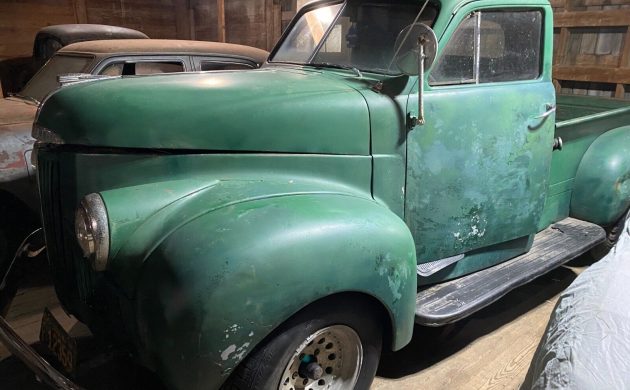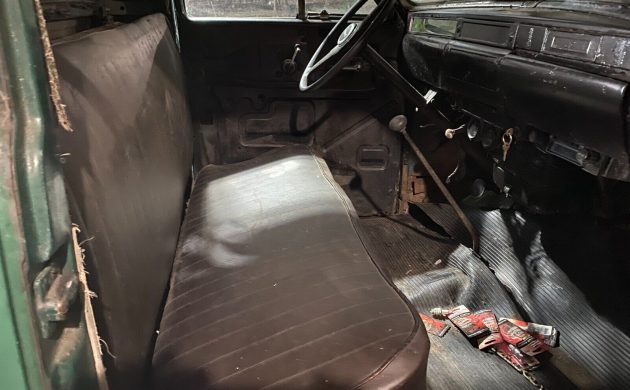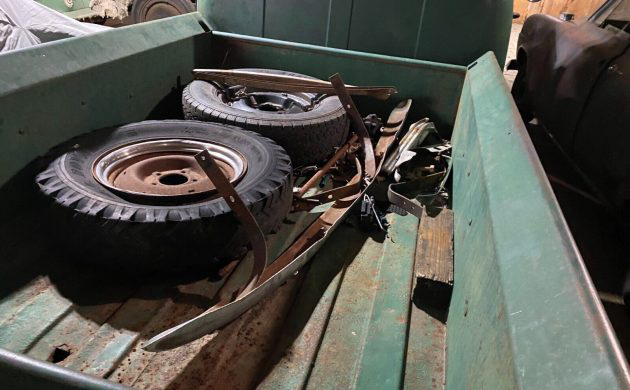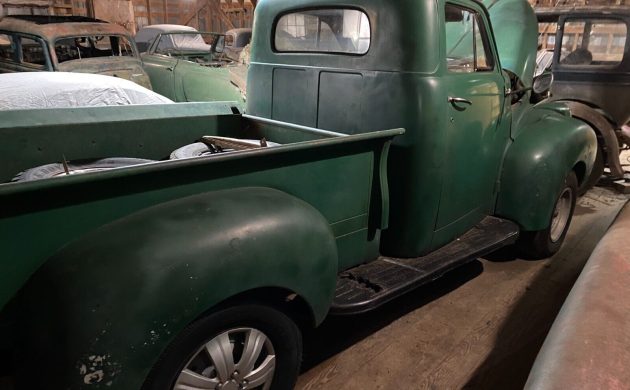Studebaker’s M-series trucks were the company’s follow-on to the swanky Coupe Express. Launched in late 1940, the M-series aggregated the upscale features of the Coupe Express and the pick-up’s serviceability – showing budding consideration for the comfort of driver and passenger. But the buyer had to pay extra for what came standard on the prior model including the Hill Holder, an interior rearview mirror, turn signals, windshield washers, bumpers, and more. Trucks were still largely built on car frames in the early ’40s – this one on the Champion’s frame. It shared the Champion’s dash and engine as well. Studebaker was ever conscious of finances, so all four fenders shared the same tooling and were swappable from front to rear. Same with the running boards – left could install on the right and vice versa. Studebaker trucks are experiencing a day in the sun as all trucks rise in value. If you want to jump into the stream, here’s a great project on eBay: a 1948 Studebaker M5 (half-ton) pick-up, currently bid to $4350, reserve not met. I probably wouldn’t drive it home in winter, but if you’re brave or nearby, you can pick it up from Marshallville, Ohio.
This truck belonged to the granddaughter of a long-term owner, who reportedly drove it until a mechanic charged her for a tune-up that didn’t happen. The seller has confirmed that the truck runs, drives, and stops. The engine didn’t want to have its picture taken, apparently, but it’s a 169.6 cu. in. six-cylinder with an output of about 80 hp. The manual ‘box is controlled with a floor shift. Research shows that two transmissions were used – a three-speed or an optional four-speed with overdrive. Typical for the vintage, it’s most comfortable at about 45 mph. The interior is well-preserved. The listing doesn’t include a photo of the band of gauges set in the dash, with their attractive Art Deco details. The seller has a pair of door panels that might go with the sale, though those need recovering.
The bed is 6 1/2 feet long; overall the M5 was several inches shorter than the Coupe Express and weighed almost 600 lbs less. It still worked like a dog for some 52,000 owners over the production run from 1941 through 1948. These numbers were a far sight better than Studebaker’s pre-war sales, giving a lift to corporate finances.
The design was by Raymond Loewy; this one’s vintage appeal is marred somewhat by the modern wheels – those bother me more than the truck’s dents and scratches. The seller notes that the cab corners are clean. We don’t know what the reserve is, but this listing offers a guide to prices, with a seller who wants $25k and a buyer offering $21,500 for a very nice example. What would you pay for this well-patina’d Studebaker?






To have the creature features it was designed with and still keep it affordable by having things like interchangeable fenders seems to indicate the appreciation the company had for the working stiff of that era.
This old timer will make someone a nice rebuild, and a good time when it’s done.
It was sold for $6500, and even that is hard to believe. I read, the M5 only had one transmission, a 4 speed with compound low, and a separate O/D could be ordered. With a 4:82 ratio, it was the only way these would see “double nickel”. A nice find, but by ’48, these were considered old looking, and the R series in ’49 was a much improved truck, visually, but I believe was nothing new underneath. A cool find, but these to me will always be worth ” a couple hundred bucks”.
Like most everything else, when I started thinking it might be cool to have an old truck old trucks went from give away prices to being worth something. Still cheaper than a lot of stuff out there. I really like the looks of these old Studebakers, though one almost got me killed a couple years ago. I saw one parked in a dusting of snow in a neighborhood Walgreen’s parking lot in December. While I was gawking at it a little old lady in a 20 year old Cadillac nearly backed into me (me, not me in the car) luckily saw her before I got squished.
I have a 47 M5 and have it in storage, in pieces, because I will restore it one day. And I really will … But I was amazed at the safety technology these things had. Mine has the hill holder, a starter cut out switch and windshield washer system. I thought it was pretty smart to have the hill holder attached to the clutch pedal. Got rid of the rear end and the straight axle front, the engine and the 4spd trans, all of which I thought I wouldn’t use and now I regret it because it will never be original, only close to it. Got a flat head Ford that I will put back in it though. Cool trucks.
Also, only paid $3500 for mine and it was in better condition, with more extra pieces than this one.
Of all the post war Studebakers the M-series always had my attention. I sure wouldn’t turn one down. Rather underpowered, but still capable of moving things around. I do have to admit that I always preferred the 3/4 to 1-ton version. They always looked better IMO…
I rode about 200 miles and up into the mountains of NC with a preacher man in an old Studebaker pickup.
Told myself then I’d never ride one of them again.
If only I were old enough to drive… My neighbor has a similar one, later generation 2r or 3r 1-ton with a 9 or 10-foot box. It appears to have the same cab as this one. Hopefully this one has the original frame and underworkings, those wheels and the stance worry me, although it may just be the downsized wheels themselves. Overall a very nice project truck, if it still has the original underpinnings, that is. I’d put some larger, off roading tires on it, maybe tow a big trailer behind it. Maybe a custom-fab supercharger to help with power since these old trucks have so much space under the hood? Well, i’ve got a couple years to think about it…
Good night to all, Flint